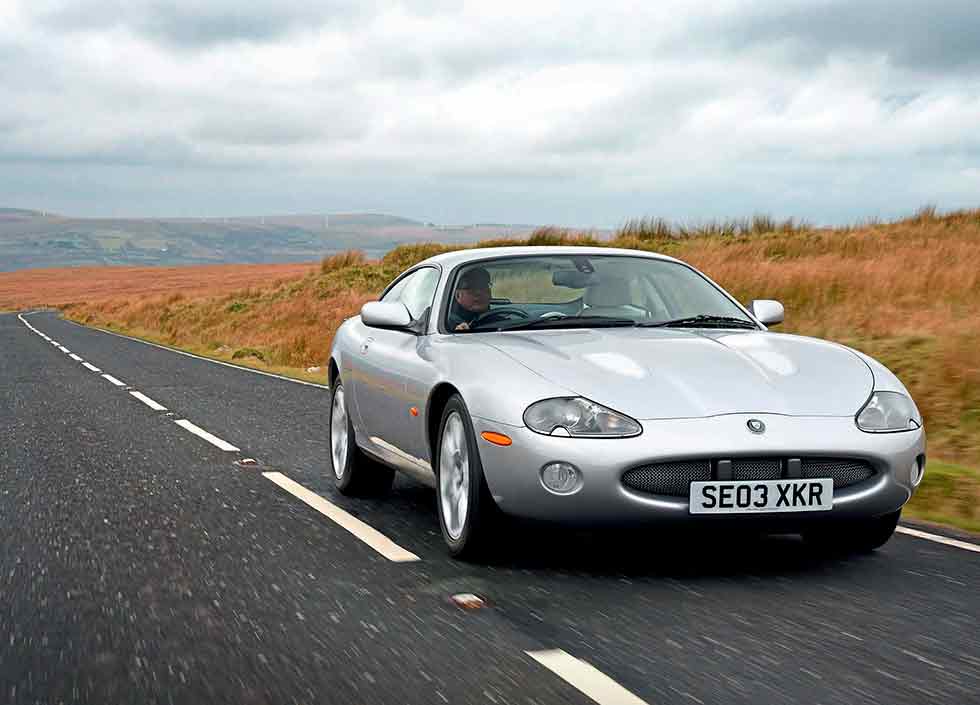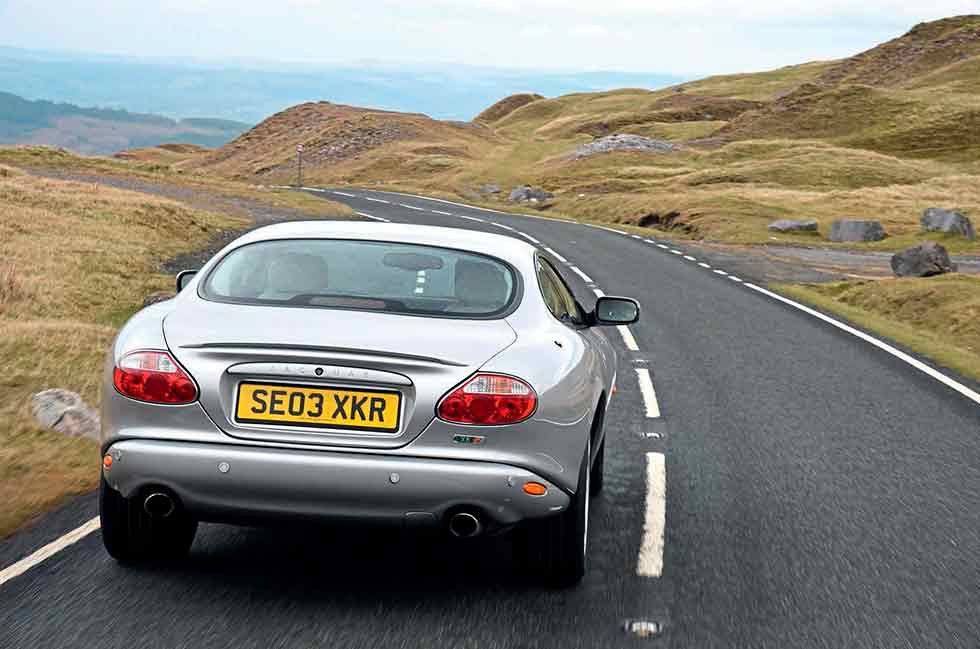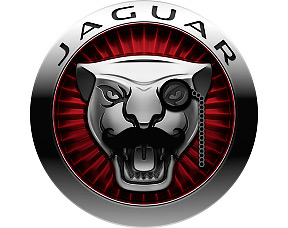
Road king We take an X100-generation XKR 4.2 along the Brecon Beacons’ notorious Black Mountain route to find out if it is Jaguar’s best-ever sports car. Words & Photography Paul Walton.
X100 2003 XKR 4.2 ON BLACK MOUNTAIN ROUTE
CLASSIC TEST
Could the X100 XKR 4.2 be the best sports car Jaguar has ever produced? To find out, we dare to drive it enthusiastically along the UK’s most dangerous route, the A4069, which cuts through the Black Mountains in the Brecon Beacons
It’s like every great corner from every great race track knitted together. A little of Spa’s famous Eau Rouge here, a touch of Silverstone’s daunting Becketts there and even a hint of Suzuka’s fast 130R in places. But this isn’t a circuit, it’s a road – a glorious ribbon of tarmac that twists, dips and climbs through the western part of the Brecon Beacons National Park, in Wales, along the Black Mountains. Due to its many corners, bleak location and stunning views, it is regarded as one of the best driving roads in the UK. It is, for the same reason, also one of the most dangerous, making it an enticing adventure – it will make the ideal location to find out whether the X100-generation XKR 4.2 is the best sports car Jaguar ever produced.

It’s a contentious issue, more so than which is the greatest Premiership football club, the best flavour of ice cream or, the biggest question of them all, Strictly or Dancing on Ice? But which is the best Jaguar sports car? I’m sure you all have your own views. The E-type is obviously a contender, as is the XK 120 and F-TYPE. But, when Colin Porter, from Swallows Jaguar, drives into the village of Brynamman in a gorgeous Platinum Silver XKR from 2003, I’d choose it on looks alone. Designed in the early Nineties by Keith Helfet and Fergus Pollock, from Jaguar’s design studio, to replace the XJS, the X100 generation of XK was always a handsome car, its long, soft-flowing lines being an obvious nod to the E-type but with its own style and character. The X100 was given a mild facelift in 2002, to include new front and rear lights, updated wheels, new and clearer badges, and better detailing – although the updates were small, they improved and modernised the design.
I’ve had to concentrate as hard as I would on any track
Later XKRs, like this, are all about stance. Thanks to lowered suspension and bigger rims, the car hunkers down more aggressively than my own 2000 XK8, which sits so high I reckon I could take it off-roading. The XKR looks a proper sports car and the perfect choice to tame the best road in the UK.
Officially called the A4069, linking Llandovery with Gwaun-Cae-Gurwen, it’s commonly known as the more ominous Black Mountain Route. I’m interested in driving the first section, between Brynamman and Pont Aber: with fast straights, long corners, tight hairpins and reaching a height of 493m (1,617ft) above sea level, it’s as daunting a piece of road as you’ll find. I know the car is up to the job, am I?

The road was built when the term ‘fun drive’ meant herding sheep in the sun. In the early 1800s, a father-and-son team – both called John Jones Brynbrain – wanted to build a road to transport coal from the family’s pits in Brynamman to the lime kilns on top of the mountain. The road would then transport the limestone down the other side of the mountain for use by the agricultural industry. The British Government granted a Turnpike Act – which grants permission for a road to be built – in 1813 and the route was completed by 1819, seven years faster than it took to build the M25 London Orbital. Today, with the weather holding – just – it’s time to see the result of John Snr and Jnr’s work.
After half a mile, the road starts to drop and twist on the other side of the mountain
Settling into the XKR’s driver’s seat, I am immediately presented with an interior that has as much wood as the Brynbrain’s parlour; a lot. By the time this particular car was sold in December 2003, the X100’s confusing layout, antiquated design and heavy use of veneer must have looked old-fashioned alongside the contemporary materials used by its German rivals; you’ll find more black vinyl and leather in the 996 generation of 911, for example, than in Catwoman’s wardrobe. Today, though, the X100 has a welcoming character that the anodyne Porsche lacks (as it does the X100’s replacement, the X150, which arrived in 2006). The X100 is comfortable, too, featuring large, soft, yet supportive seats, plus plenty of room in the front, albeit the rear is hilariously tight. I’ve driven thousands of miles all over Europe in several variants of F-TYPE and all of them have been exciting, but, for comfort, I’d rather take an X100.
I reckon the 4.2 is also better built than the 4.0 models (or even the X150, which features too much cheap plastic for a luxury sports car). The gaps between the panels are tighter, the wood and leather is thicker and it feels generally better screwed together. Although there are only three years between this and my car, based on the quality of their interiors, it could be 30.
When I start the engine, the 4.2 V8’s growl is a deeper baritone on tickover than the 4.0 – a forewarning of its menacing character? The engine hadn’t only been increased in size by 200cc when it arrived in 2002, the same time as the exterior refresh, it had been redesigned. The pistons were machined from single billets of aluminium and jet cooling on the underside was added.
The new engine also had the advantage of variable camshaft phasing: an hydraulic actuator on each engine inlet camshaft was operated by a pair of electronically switched oil-pressure-control valves actuated by the engine control module, which contains the maps of the engine speeds and loads. This resulted in improved engine response and optimum performance at all speeds. The fuelling system was upgraded, too – multihole injectors refine the spray pattern – while a redesigned block and end plate means the 4.2 is 6kg lighter than the 4.0. Another mechanical change was the adoption of ZF’s six-speed gearbox (ZF 6HP), replacing the Mercedes-Benz five-speeder used in the XKR 4.0.
The engine feels strong and muscular, encouraging me to rev it hard
The road is invitingly empty as I slot the gearlever down into drive, squeeze the throttle and find my way out of Brynamman.
The change from urban to desolate countryside comes the moment I cross over a bone-shaking cattle grid and pass into the Brecon Beacons National Park. Like a scene From Game of Thrones, the Black Mountains rise ahead of me, a sea of brown against the slate-grey sky of this cold November morning. And, somewhere out there, stretches the A4069, weaving its way through the mountains like a slender river in asphalt.
Although the gradient is steep, this first section of the route features long straights and open bends, allowing me to squeeze the throttle hard. The V8 responds instantly, rewarding me with an aggressive burst of speed, an experience intensified by the atmospheric whine of the Eaton supercharger (sadly lacking from the current crop of supercharged Jaguars). Although the XKR 4.2’s 0-60mph time (5.2 seconds) is 1.7 seconds slower than the F-TYPE SVR’s, acceleration is still quick, pushing me back into the seat with surprising forcefulness.
The engine feels strong and muscular, encouraging me to rev it hard, especially after pressing the small sport button next to the gearlever. In modern Jaguars, engaging sport mode turns the dials red so you can be in no doubt as to what you’ve done; in the XKR, a tiny and easy-to-miss red bulb illuminates within the button itself. Less dramatic but also – like everything else about the XKR – more discreet.
Two-and-a-half miles later, the road starts to level out, but not the mountains. Either side of me are vast, formidable peaks that are popular with hikers (I don’t know why, either, when there’s this amazing road). If there are any here today, I’ll be a silver missile shooting through the barren countryside.
And it really is barren at this point. I pass Herbert’s Quarry, the location of the former limestone excavation. Still strewn with large lumps of grey rock and marred by deep gashes in the hillside, it is an apocalyptic scene. It must have been a hard place to work even if the road did make access easier. Not only is it windy and desolate here, but the nearest Starbucks is ten miles away.
After half a mile, the road starts to drop and twist on the other side of the mountain. The first serious corner is a tight right-hand hairpin known as Tro Gwcw (the Cuckoo Turn) that gives panoramic views over Gwynfe and Llangadog, way in the distance. Not that I have time to enjoy them; at 1,753kg (50kg more than the F-TYPE SVR coupe), the X100 is a heavy lump and I can feel its weight through the tight bend. Although the suspension is nicely damped, lessening body roll, there’s no denying the lightweight F-TYPE would be much faster through here than the heavyweight XKR.
Plus, I miss the fun of the steering wheel mounted paddles fitted to all Jaguars from the X150 XK onwards. If I were in an F-TYPE, I could have manually dropped down a couple of gears in preparation for the bend. Although the XKR features Jaguar’s renowned J-gate, allowing me to go up and down the gears, it’s not as easy to use – or as fast – so I let the six-speed ’box do the work.
Where the XKR wins over the newer sports car is its ride. The F-TYPE is notoriously hard, so even the smallest piece of gravel is felt in the cabin and, in comparison, the X100’s suspension is wonderfully supple. The A4069 isn’t the smoothest of roads, yet the big Jaguar irons out bumps and potholes to make it a more relaxing drive than in either the F-TYPE or the X150 XKR.
Well, it would be if there was a barrier on the road. Instead, to the left of me there’s nothing but a sheer drop. If I drive off the road I won’t stop tumbling until I reach Cardiff. Not only is the A4069 one of the best roads in the UK, it’s also one of the most dangerous.
The road now drops quickly and, facing another straight, I put my foot down, the torquey engine responding instantly. It’s loud enough to disturb the peace and quiet, like a teenagers’ party, but is nothing compared to the F-TYPE SVR or the ludicrous XE Project 8.
After a tight left-hand hairpin over an ancient and crumbly bridge, there’s a delicious series of right-left-right corners. The steering clearly isn’t as quick as a newer car’s, but the XKR still flies through the bends, the standard CATS (computer active technology suspension) ensuring the car remains stable and composed.
After another quick straight, and a cattle grid, the road changes as instantly as it did at the start. No longer surrounded by peaks, with trees either side creating a tunnel of foliage, the next couple of miles to Pont Aber lack the drama of the mountaintop. But, it has been an amazing adventure and I’ve had to concentrate as hard as I would on any track. The car, though, definitely made it easier. Although it clearly lacks the lightness of an F-TYPE, for example, or even a well setup E-type, thanks to its responsive engine, composed chassis and clever suspension, it handled the road well. If it were 100kg lighter, the car would be a match for the F-TYPE, but would it be as comfortable?
The XKR looks a proper sports car and the perfect choice to tame the best road in the UK
This mix of comfort and performance (as well as good looks) is why I put the X100 XKR 4.2 on a pedestal, because it’s a combination other Jaguar sports cars don’t have. The XJS, for example, is gorgeous and powerful, but its size and weight mean it lacks the X100’s drivability, while the quicker F-TYPE lacks the XKR’s discrete looks, space and comfort. And while the older models are icons – the XK range and all series of E-type – they don’t offer the same performance.
Then, there’s value. You’re looking at £200k for an early E-type open-two-seater, and still half that for a V12. The entry F-TYPE P300, with the four-cylinder engine, was £52,310 at the time of writing and although early examples of the supercharged V6 are incredible value at £25k, the bargain here is the XKR 4.2. This gorgeous, 42k-mile silver example is for sale at Swallows Jaguar for just £15k – and you’ll find higher-mileage cars for less than half that. I’ve spent more on a used diesel hatchback.
Deciding on which is Jaguar’s best sports car is a contentious issue, but to not consider the XKR 4.2 as a candidate is even more so.
Thanks to: Swallows Jaguar for supplying the gorgeous XKR used for the feature. To see this and many other cars for sale, please visit www.swallows-jag.co.uk or call 01934 750319
2003 Jaguar XKR 4.2 X100
Engine 4,196cc SC V8
Max Power 400bhp @ 5900rpm
Torque 408lb ft @ 2800rpm
0-60mph 5.2secs
Top speed 155mph
Transmission 6-spd auto
Economy 22.9mpg
Price new £56,700
Value now £5k-£15k






